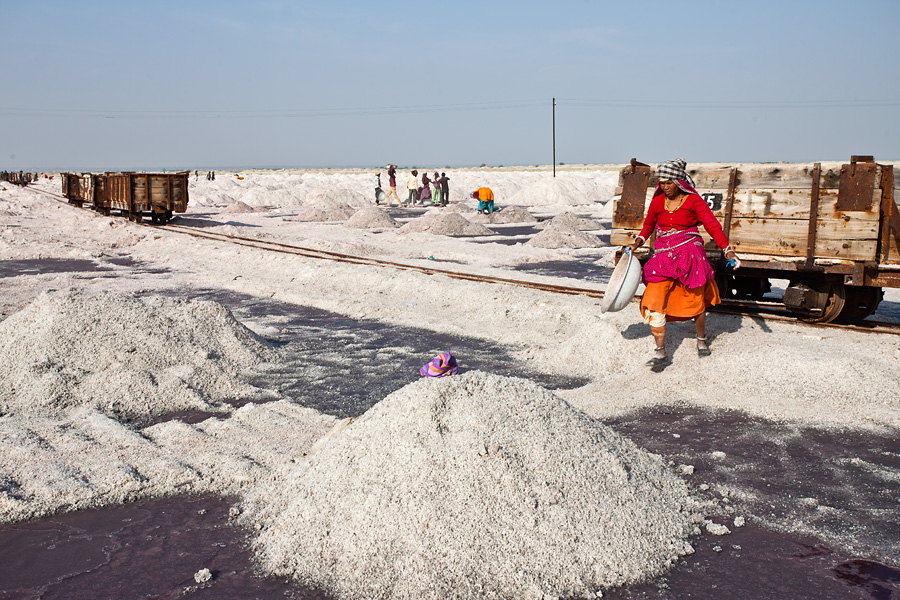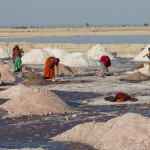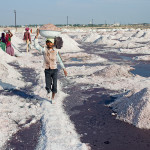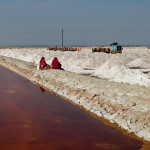Salt Pans of Sambhar Lake, Rajasthan
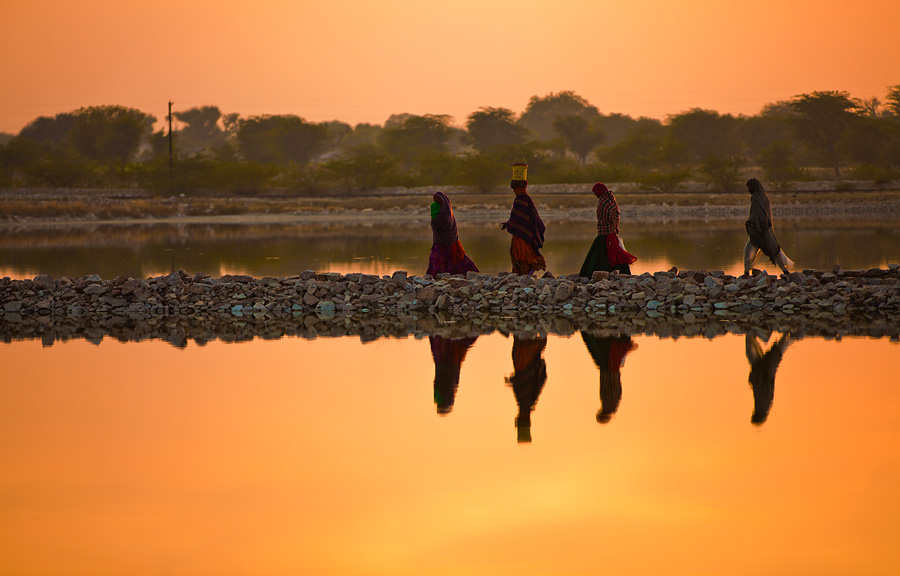
There was not a single blade of grass could be seen in the endless, perfectly plain landscape that expanded towards the horizon in front of Shakambari Temple. The earth was flat as though a road roller ran amok for ages until the smallest aberrations were pressed in and done away with. The monotony of a dry, drought-struck earth was broken by a few deeply entrenched tyre-marks forming a line that extended to infinity. Our driver descended gently into the flat, testing the firmness of the ground with a bit of uncertainty, wondering if the car would sink into the ground.
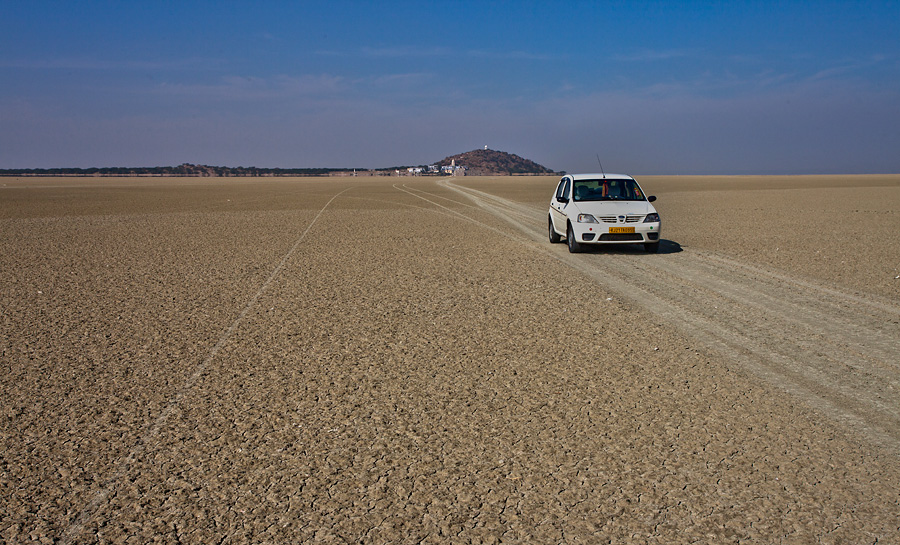
The dry lake-bed of Sambhar Lake. Seen far behind at the base of the hill is Shakambari Devi Temple.
It took less than a minute for him to realize that we were on a ground as firm and clear as a runway. He gently pressed on the pedal, not slowing down until the speedo hit three figures. In the back seat, it was such a smooth ride that we did not realize the speed until we were mentioned about it. We slowed down, stopped in the middle of the flats where we could start seeing a few trees and buildings on the other end. We were now in the center of Sambhar Lake, a large salt water lake that was mostly dry in the winter season.
We had driven to Sambhar from Jaipur in the middle of a pleasant winter, searching for the salt-pans of Sambhar. Driving past Sambhar Town located at the eastern edge of the lake, we had circled the lake to the western corner at Shakambari Devi Temple. Much of the lake was now dry, except for a few stretches here and there and a section that hosted the salt pans. A flamingo here and a flamingo there waded the waters. The area around the temple had probably not seen much water in a long time, allowing local villagers to use the lake as a thoroughfare. It was on one such path that we had managed to touch three-figure speeds.
Returning from the temple premises, we entered the salt pans where work was in full swing. But our first sight was not the hard-working men and women, but a curious looking train that chugged through the pans.

The train, which is used for carrying raw-salt from the fields to the refinery, moves through the salt pans.
This train is meant to transport salt from the pans to a refinery nearby. The modus operandi is simple: workers fill the trolleys left behind in the pans with dried up salt. When there are enough trolleys filled with raw salt, the train comes in and takes the trolleys away and delivers it to the factory barely a kilometer away.
The entire workflow appears like a scene that belongs to a past. A small number of earth-movers could have easily replaced the entire set of workers. A handful of tipper-trucks could do a better job than the toy-train. But the system is working, it can employ many, and it will continue to stay as there is no compulsion to modernize. A salt pan with hundred of years of history is not going shake up and change in a day!
While the local workers said that the lake was yielding salt for a thousand years, some account attribute the first extractions to the time of Mughal King Babur (15th-16th century). In the later years, Sambhar Lake came into the hands of British, who brought in mechanization and introduced the interesting-looking toy-train. Today, the refinery is owned by Hindustan Salts Limited. The workers are farmers from nearby villages who come here to make additional income in the seasons when they don’t have much work in their farms. One of them told us that their landholdings are small, thanks to continuous division of farmland within the families over generations, and they have to find additional sources of income to make ends meet.
But… Sambhar Lake’s days are probably numbered!
The lake, which used to have ten-feet high waters a few decades ago has now run completely dry. It hasn’t seen any water for several years now despite good monsoons in the region. Most of the inlets to the lake have been dammed and diverted, and the flow of water to the lake has ceased almost completely. The salt industry now relies on water extracted from bore-wells. This may not continue forever, and the industry may have to shut shop when the bore-wells eventually run dry.
This lack of water also has other implications. Sambhar is a Ramsar Wetland, and was known for its huge flocks of flamingos and many other winter visitors. But their numbers have declined steadily over the years, and the last year has seen less than hundred flamingoes. While I was there, I saw exactly two of them and there wasn’t anything to call a flock. I could rarely see any other bird species either. If there is no water, naturally the wading birds would have no business there.
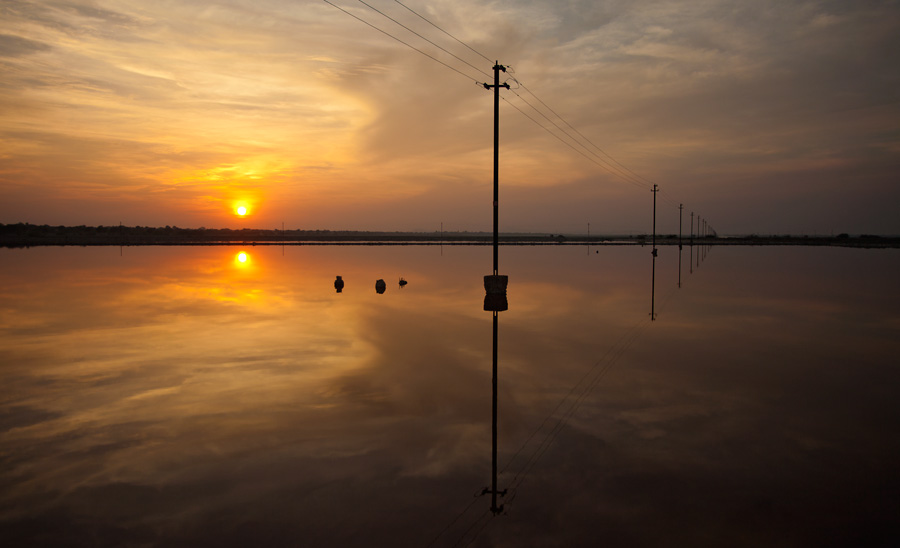
Salt pans reflect the evening sky
Nonetheless, as of now Sambhar continues to be busy and employs a considerable number of people at the salt pans. I can’t recall well, but we probably saw about three dozen people in the fields, belonging to two different family groups. And there were also the train operators, engineers and people at the refinery that we did get to see.
And while it is operating, the atmosphere of the salt fields is beautiful, perhaps with a touch of romance created by the toy-train. As the train slowly rolls forward on a dyke separating the salt-pans, it looks much like those slow-moving trains in the hill stations loved by the tourists. You could easily imagine a bollywood actor jumping out from the train any moment and a bunch of women smiling and shaking their legs to a loud jingle.
The now dry lake-bed has indeed played host to making of several bollywood movies. Now, that’s a topic I wouldn’t want to drift into!
Sambhar Lake – travel information
Sambhar Lake is about 2.5 hours drive from Jaipur. This is a deviation from Jaipur – Ajmer highway. The lake is two hours away from Ajmer/Pushkar as well. So, if you are driving from Jaipur to Ajmer/Pushkar, you can consider making a deviation to Sambhar Lake. You can also take a train from Jaipur to Sambhar Lake Station (about one hour), but you will need a vehicle to move around once you get to Sambhar Lake Station.
There are no visitor facilities available anywhere near the lake – no accommodation and no restaurants. A day-visit would be appropriate, and ensure that you carry everything you may require during the visit. It would be wise to carry plenty of water.
Sunsets over the salt-pans can be beautiful in winter months. We recommend that you arrive some time in the afternoon, spend a couple of hours and return after sunset.
